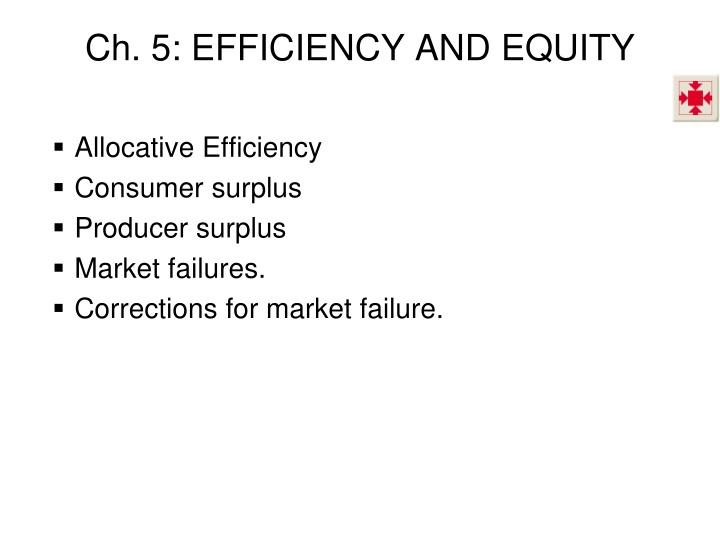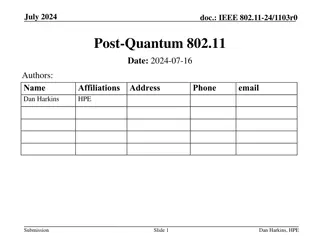
Allocative Efficiency and Market Failures
Learn about allocative efficiency, consumer surplus, producer surplus, and market failures in economics. Discover how corrections for market failures can help achieve efficiency and equity in resource allocation.
Download Presentation

Please find below an Image/Link to download the presentation.
The content on the website is provided AS IS for your information and personal use only. It may not be sold, licensed, or shared on other websites without obtaining consent from the author. If you encounter any issues during the download, it is possible that the publisher has removed the file from their server.
You are allowed to download the files provided on this website for personal or commercial use, subject to the condition that they are used lawfully. All files are the property of their respective owners.
The content on the website is provided AS IS for your information and personal use only. It may not be sold, licensed, or shared on other websites without obtaining consent from the author.
E N D
Presentation Transcript
Ch. 5: EFFICIENCY AND EQUITY but1 Allocative Efficiency Consumer surplus Producer surplus Market failures. Corrections for market failure.
Efficiency and the Social Interest but1 Allocative efficiency occurs when it is not possible to produce more of a good or service without giving up some other good or service that is valued more highly. depends on people s preferences.
Allocative Efficiency but1 Marginal Benefit (MB) the benefit a person receives from consuming one more unit of a good or service. the dollar value of other goods and services that a person is willing to give up to get one more unit of it. decreasing marginal benefit implies that as more of a good or service is consumed, its MB decreases.
Allocative Efficiency but1 For any given price, a consumer will buy all units of the good where MB>P The MB curve will be identical to the consumer s demand curve. Market demand curve is summation of individual MB curves P MB Q
Allocative Efficiency but1 Marginal Cost the opportunity cost of producing one more unit of a good or service. the dollar value of other goods and services required to produce one more unit of the good. increasing marginal cost implies that as more of a good or service is produced, its marginal cost increases.
Allocative Efficiency but1 Law of Increasing MC: MC curve is upward sloping. A firm will produce all units of a product where P>MC The MC curve is the firm s supply curve (more details later). MC P Q
Allocative Efficiency Efficiency and Inefficiency If MB>MC, should produce and consume more of the good. If MB<MC, should produce and consume less of the good. If MB=MC, allocative efficiency obtained. but1 MC MB Q* Quantity
Value, Price, and Consumer Surplus but1 Consumer Surplus Difference between maximum amount consumers are willing to pay and the price of a good. Measured by the area under the demand curve (MB curve) and above the price paid, up to the quantity bought.
Value, Price, and Consumer Surplus but1
Cost, Price, and Producer Surplus Producer Surplus the price of a good minus the marginal cost of producing it, summed over the quantity sold. measured by the area below the price and above the supply curve, up to the quantity sold. but1
Cost, Price, and Producer Surplus but1
Is the Competitive Market Efficient? but1 At the equilibrium quantity, MB=MC, so the quantity is the allocatively efficient quantity. The sum of consumer and producer surplus is maximized at this efficient level of output.
Obstacles to Efficiency but1 Externalities Price ceilings and floors Taxes, subsidies, and quotas. Monopoly Public goods and common resources
Externalities but1 When there are negative externalities: Social MC = Private MC + per unit negative externality When there are positive externalities: Social MB = Private MB + per unit positive externality Regardless of whether there are externalities, in a competitive market: Supply = Private MC Demand = Private MB
Is the Competitive Market Efficient? but1 When there are negative externalities, SMC deadweight loss S=PMC SMC>PMC The market produces too much neg externality deadweight loss results D=PMB=SMB Taxes could fix market. Q Q market efficient
Is the Competitive Market Efficient? but1 When there are positive externalities, deadweight loss S=PMC=SMC SMB>PMB The market produces too little SMB pos ext. deadweight loss results D=PMB Qmarket Qefficient Subsidies could fix market.



















